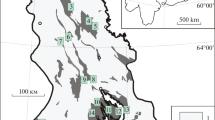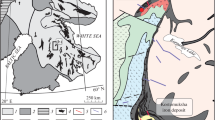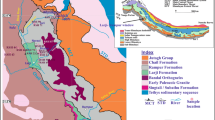Abstract
The results of studies of carbonaceous matter (CM) and the S isotopic composition of associated sulfides in metapelites of the Neoarchean banded iron formation of the Kostomuksha greenstone belt of Karelia (Karelian Craton of the Fennoscandinavian Shield) are presented. The petrographic observations show that the CM occurs inside and between silicates, in sulfides, or at the grain boundaries between the sulfide crystals and biotite or amphibole. The results of scanning electron and atomic force microscopy showed the presence of several CM types distinct in structure and C content. The analysis of Raman spectra of CM revealed the presence both of well-ordered graphite and weakly structured kerogene in samples. The isotopic composition of the total organic carbon is typical of biogenic processes. The δ13Corg values from –27.9 to –30.6‰ are consistent with the fixation of carbon by photo- or chemoautotrophs. The S isotopic composition of associated sulfides is characterized by a positive Δ33S anomaly (up to +0.94‰) and negative δ34S values (from –2.06 to –4.1‰). The positive Δ33S values indicate a genetic link with photochemical elemental sulfur (S8) from the atmosphere, whereas the negative δ34S values reflect the fractionation of isotopes during bacterial-related processes. Based on these observations, we suggest that the primary CM mostly has a biogenic origin.


Similar content being viewed by others
REFERENCES
K. O. Konhauser, N. J. Planavsky, D. S. Hardisty, et al., Earth-Sci. Rev. 172, 140–177 (2017). https://doi.org/10.1016/j.earscirev.2017.06.012
M. M. Astafieva, S. B. Felitsyn, and N. A. Alfimova, Paleontol. J. 51 (4), 430 (2017).
M. S. Dodd, D. Papineau, et al., Earth Planet. Sci. Lett. 512, 163–174 (2019). https://doi.org/10.1016/j.epsl.2019.01.054
C. Klein, Am. Mineral. 90, 1473–1499 (2005).
S. McMahon, R. P. Anderson, E. E. Saupe, and D. E. G. Briggs, Geology 44, 867–870 (2016).
E. R. Sharman, B. E. Taylor, W. G. Minarik, et al., Miner. Deposita 50, 591–606 (2015).
S. V. Vysotskiy, A. I. Khanchuk, T. A. Velivetskaya, A. V. Ignatiev, A. V. Aseeva, and N. S. Nesterova, Dokl. Earth Sci. 510 (2), 394–400 (2023).
A. I. Slabunov, N. S. Nesterova, A. V. Egorov, L. V. Kuleshevich, and V. I. Kevlich, Geochem. Int. 59 (4), 341–357 (2021). https://doi.org/10.1134/S0016702921040066
A. I. Slabunov, S. A. Svetov, A. V. Stepanova, P. V. Medvedev, and A. K. Polin, Tr. Karel. Nauch. Tsentra Ross. Akad. Nauk, No. 5, 132–138 (2022). https://doi.org/10.17076/geo1690
Kostomuksha Ore District: Geology, Deep Structure and Minerageny, Ed. by V. Ya. Gor’kovets and N. V. Sharov (Petrozavodsk, 2015) [in Russian].
T. Velivetskaya, A. Ignatyev, M. Reize, and S. Kiyashko, Rapid Commun. Mass Spectrom. 21, 2451–2455 (2007). https://doi.org/10.1002/rcm.3112
A. V. Ignatiev, T. A. Velivetskaya, S. Y. Budnitskiy, V. V. Yakovenko, S. V. Vysotskiy, and V. I. Levitskii, Chem. Geol. 493, 316–316 (2018). https://doi.org/10.1016/j.chemgeo.2018.06.006
A. S. Ferrari and J. Robertson, Phys. Rev. B 61, 14095–14107 (2000).
M. Schidlowski, Precambrian Res. 106 (1-2), 117–134 (2001). https://doi.org/10.1016/S0301-9268(00)00128-5
J. Farquhar, B. A. Wing, K. D. McKeegan, J. W. Harris, P. Cartigny, and M. H. Thiemens, Science 298, 2369–2372 (2002).
S. Ono, J. L. Eigenbrode, A. A. Pavlov, P. Kharecha, D. Rumble III, J. F. Kasting, and K. H. Freeman, Earth Planet. Sci. Lett. 213 (1-2), 15–30 (2003).
J. Farquhar, J. Cliff, A. L. Zerkle, and B. Harms, Proc. Natl. Acad. Sci. USA 110, 17638–17643 (2013).
W. D. Leavitt, I. Halevy, A. S. Bradley, and D. T. Johnston, Proc. Natl. Acad. Sci. USA 110, 11244–11249 (2013).
ACKNOWLEDGMENTS
We are grateful to the direction and staff of the Mining and Processing Plant Karelskii Okatysh (Kostomuksha) for assistance during scientific geological studies in the open pits.
Funding
This work was supported by the Russian Science Foundation, project no. 21-17-00076, https://rscf.ru/project/21-17-00076/.
Author information
Authors and Affiliations
Corresponding author
Ethics declarations
The authors declare that they have no conflicts of interest.
Additional information
Translated by I. Melekestseva
Publisher’s Note.
Pleiades Publishing remains neutral with regard to jurisdictional claims in published maps and institutional affiliations.
Rights and permissions
About this article
Cite this article
Vysotskiy, S.V., Khanchuk, A.I., Velivetskaya, T.A. et al. New Evidence of the Organic Origin of Carbonaceous Matter in Archean Banded Iron Formation of the Kostomuksha Greenstone Belt of Karelia, Russia. Dokl. Earth Sc. (2023). https://doi.org/10.1134/S1028334X23602730
Received:
Revised:
Accepted:
Published:
DOI: https://doi.org/10.1134/S1028334X23602730




